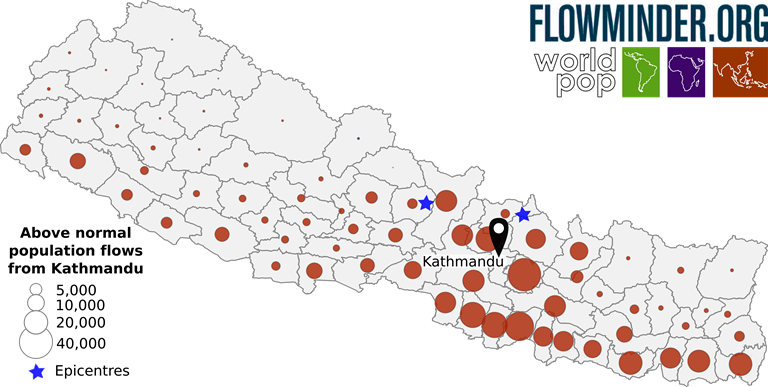By Robin Wilson, Elisabeth zu Erbach-Schoenberg, Maximilian Albert, Daniel Power, Simon Tudge, Miguel Gonzalez, Sam Guthrie, Heather Chamberlain, Christopher Brooks, Christopher Hughes, Lenka Pitonakova, Caroline Buckee, Xin Lu, Erik Wetter, Andrew J Tatem, and Linus Bengtsson.
The value of CDRs, when integrated with more traditional data sources within modelling frameworks, has been shown across multiple disease, development and disaster scenarios. The field of CDR analytics in the humanitarian space is therefore moving beyond pilot studies and towards a more mature and operationally valuable platform. Here we have shown how this can be achieved in a disaster response situation through the partnership of scientists, mobile network operators and response agencies.
Abstract
Sudden impact disasters often result in the displacement of large numbers of people. These movements can occur prior to events, due to early warning messages, or take place post-event due to damages to shelters and livelihoods as well as a result of long-term reconstruction efforts. Displaced populations are especially vulnerable and often in need of support. However, timely and accurate data on the numbers and destinations of displaced populations are extremely challenging to collect across temporal and spatial scales, especially in the aftermath of disasters. Mobile phone call detail records were shown to be a valid data source for estimates of population movements after the 2010 Haiti earthquake, but their potential to provide near real-time ongoing measurements of population displacements immediately after a natural disaster has not been demonstrated.

Anomalous flows from the Kathmandu valley, comparing the 10th-14th May with the 20th-24th April.
Methods: A computational architecture and analytical capacity were rapidly deployed within nine days of the Nepal earthquake of 25th April 2015, to provide spatiotemporally detailed estimates of population displacements from call detail records based on movements of 12 million de-identified mobile phones users.
Results: Analysis shows the evolution of population mobility patterns after the earthquake and the patterns of return to affected areas, at a high level of detail. Particularly notable is the movement of an estimated 390,000 people above normal from the Kathmandu valley after the earthquake, with most people moving to surrounding areas and the highly-populated areas in the central southern area of Nepal.
Discussion: This analysis provides an unprecedented level of information about human movement after a natural disaster, provided within a very short timeframe after the earthquake occurred. The patterns revealed using this method are almost impossible to find through other methods, and are of great interest to humanitarian agencies.